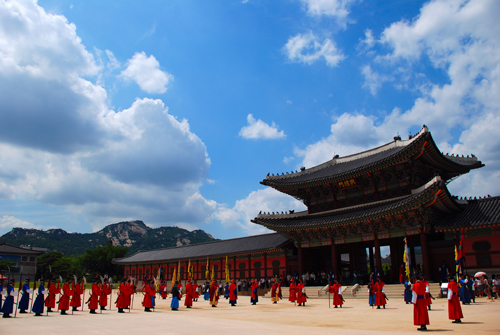
They say spring is the king of all seasons. Those ready to become royalty are invited to take a king-like spring stroll through Gyeongbokgung Palace , the main royal palace of the Joseon Dynasty. “Come to view Korea’s treasures,” says Jang Jae-hyuck, a staff member at Gyeongbokgung Palace office of publicity and research.
National Palace Museum of Korea
Before entering Gyeongbokgung Palace , next to the entrance is the National Palace Museum of Korea where one can sneak a preview into the secret treasures of the Royal Joseon Court, its architectural features, and royal life. The museum is free of admission until December 31 and is closed every Monday.
Geunjeongjeon, Throne Hall
Past the museum lies a place of real royal life. The breezy and spacious courtyard is the grand backdrop of Geunjeongjeon, the largest and most formal hall of Gyeongbokgung Palace where the king sat on his high throne to meet his officials and envoys from oversees. Officials found their places on the stone courtyard in front of the hall where each of their ranks was marked by small stones. The uneven stone slabs of the floor are cleverly crafted so as to not blind the person who stands on it – an attentive detail that shows how well the phrase "diligence helps governance," the meaning of Geunjeongjeon, was actually lived.
Place of sheer beauty, Gyeonghoeru Pavilion
Past the hall is Gyeonghoeru, once a place of lavish banquets and greetings for foreign envoys. A man-made pond and a tree that changes its color every season surrounds the place where music never ceased. In spring, cherry blossoms and forsythias bloom to greet visitors. The beauteous view of the mountain Inwang can be viewed from the pavilion. When walking around, give a closer look on the three bays at the center that symbolizes heaven, earth, and man, and the ridges of the roof that contains 11 mythical figures. Take time to relax at Gyeonhoeru, watching the beautiful architecture that shows concise but gorgeous features of the late Joseon dynasty.
The National Folk Museum of Korea
Near the exit of the royal palace awaits a place of sudden reality, a museum located next to Jipgyeongdang of Gyeongbokgung Palace that shows how ordinary folk lived in traditional times. Two million visitors visit this place annually. Admission is free until December 31 and the museum is closed every Tuesday.
By Kang Sung-hye & Lee ji-yoon

